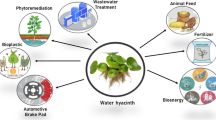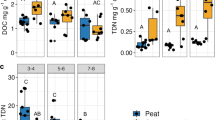Abstract
Drainage water reuse systems have been proposed for the west side of the San Joaquin Valley of California in order to reduce the volumes of water requiring disposal. Implementation of this system requires development of a cropping system with successively higher salt tolerance. A major limitation is the need to identify alternate species that will be suitable as the final, most salt tolerant crop in the series. These crops must be productive when irrigated with waters that are typically high in sulfate salinity and may be contaminated with potentially toxic trace elements. This study was initiated to evaluate the interactive effects of sulfate salinity and selenium on biomass production and mineral content of purslane (Portulaca oleracea). Plants were grown in greenhouse sand cultures and irrigated four times daily. Treatments consisted of three salinity levels with electrical conductivities (ECi) of 2.1, 15.2, and 28.5 dS m−1, and two selenium levels, 0 and 2.3 mg L−1. In the initial harvests, shoot dry matter was reduced by 15 to 30% at 15.2 dS m−1 and by 80 to 90% at 28.5 dS m−1. Regrowth after clipping above the first node was vigorous and biomass from plants irrigated with 15.2 dS m−1 water was nearly double that from the 2 dS m−1 treatment. Purslane appears to be an excellent candidate for inclusion in saline drainage water reuse systems. It is (i) highly tolerant of both chloride- and sulfate-dominated salinities, (ii) a moderate selenium accumulator in the sulfate-system, and (iii) a valuable, nutritive vegetable crop for human consumption and for livestock forage.
Similar content being viewed by others
References
Banuelos G S, Cardon G E, Phene D J, Wu L, Akohoue S and Zambrzuski S 1993 Soil boron and selenium removal by three plant species. Plant Soil 148, 253-263.
Banuelos G S and Meek D W 1990 Accumulation of selenium in plants grown on selenium-treated soil. J. Environ. Qual. 19, 772-777.
Banuelos G S, Meek D W and Hoffman G J 1990 The influence of selenium, salinity, and boron on selenium uptake on wild mustard. Plant Soil 127, 201-206.
Boursier P and Läuchli A 1990 Growth responses and mineral nutrient relations of salt-stressed sorghum. Crop Sci. 30, 161-174.
Curtin D, Steppuhn H R and Selles F 1993 Plant responses to sulfate and chloride salinity: Growth and ionic relations. Soil Sci. Soc. Am. J. 57, 1304-1310.
Flowers T J, Hajibagheri M A and Clipson N JW 1986 Halophytes. Quart. Rev. Biol. 61, 313-337.
Grattan S R and Grieve C M 1993 Mineral nutrient acquisition and response by plants grown in saline environments InHandbook of Plant and Crop Stress. Ed. Pessarakli. pp 203-225. Marcel Dekker, Inc., New York.
Hanks R J, Gardner H R and Florian R L 1969 Plant growth-vapotranspiration elations for several crops grown in the Central Great Plains. Agron. J. 61, 30-34.
Khan A H, Ashraf M Y, Naqvi S S M, Khanzada B and Ali M 1995 Growth, ion and solute contents of sorghum grown under NaCl and Na2SO4 salinity stress. Acta Physiol. Plant. 17, 261-268.
Kumamoto J, Scora R W, Clerx W A, Matsumura W A, Layfield D and Grieve CM 1990 Purslane: A potential new vegetable crop rich in omega-3 fatty acid with a controllable sodium chloride content. Proceedings of the First International Conference on New Industrial Crops and Products, Riverside CA. Eds. H H Naqvi, A Estilai and I P Ting. pp 229-233. Univ. of Arizona, Tucson, AZ.
Läuchli A 1993 Selenium in plants: Uptake, functions, and environmental toxicity. Bot. Acta 106, 455-468.
Maas E V and Hoffman G J 1977 Crop salt tolerance-current assessment. J. Irrig. Drainage. ASCE 103 (IR2), 115-134.
Mahmood K, Vanderdeelen J and Baert L 1995 Phosphorus uptake by Kallar grass (Leptochloa fuscaL.) from different depths in saline and non-saline soil. Eur. J. Agron. 4, 245-251.
Matthews J F, Ketron D W and Zane S F 1993 The biology and taxonomy of Portulaca oleraceaL. (Portulacaceae) complex in North America. Rhodora 95, 166-183.
Mikkelsen R L, Haghnia G H, Page A L and Bingham F T 1988 The influence of selenium, salinity, and boron on alfalfa tissue composition and yield. J. Environ. Qual. 17, 85-88.
Mor R P and Manchanda H R 1992 Influence of phosphorus on the tolerance of table pea to chloride and sulfate salinity in a sandy soil. Arid Land Res. Rehab. 6, 41-52.
National Research Council 1989 Recommended Dietary Allowances. 10th Edition. National Academy of Sciences, Washington, DC.
Ohlendorf H M and Santolo G M 1994 Kesterson reservoir-past, present, and future: An Ecological risk assessment. InSelenium in the Environment. Eds. W T Frankenberger and S Benson. Chap 4, pp 69-117. Marcel Dekker, Inc., New York.
Omara-Alwala T R, Mebrahtu T, Prior D E and Ezekwe M O 1991 Omega-three fatty acids in purslane (Portulaca oleracea) tissues. JAOCS 68, 198-199.
Parker D R, Page A L and Thomason D N 1991 Salinity and boron tolerances of candidate plants for the removal of selenium from soils. J. Environ. Qual. 20, 157-164.
Power J F, Grunes D L and Reichmann G A 1961 The influence of phosphorus fertilization and moisture on growth and nutrient absorption by spring wheat: I. Plant growth, N uptake, and moisture use. Soil Sci. Soc. Am. J. 25, 207-210.
Presser T, Swain W C, Tidball R R and Severson R C 1990 Geologic sources, mobilization, and transport of selenium from the California coast ranges to the western San Joaquin Valley: A reconnaissance study. US Geol. Surv. Invest. Report 90-4070.
Rhoades JD 1989 Intercepting, isolating, and reusing dranage waters for irrigation to conserve water and protect water quality. Agric. Water Manage. 16, 37-52.
Simopoulos A P, Norman HA, Gillaspy J E and Duke JA 1992 Common purslane: a source of omega-3 fatty acids and antioxidants. J. Am. Coll. Nutr. 11, 374-382.
Simopoulos A P and Salem N Jr 1986 Purslane: a terrestial source of ω-3 fatty acids. N. Engl. J. Med 15, 833.
Suarez D and Grieve CM 1988 Predicting cation ratios in corn from saline solution composition. J. Exp. Bot. 39, 605-612.
Van Genuchten M Th and Hoffman G J 1984 Analysis of crop salt tolerance data. InSoil Salinity Under Irrigation. Ecological Studies Vol. 51. Eds. I Shainberg and J Shalhavet. pp 258-271. Springer Verlag. Berlin.
Warne P, Guy R D, Rollins L and Reid D M 1990 The effects of sodium sulphate and sodium chloride on growth, morphology, photosynthesis, and water use efficiency of Chenopodium rubrum. Can. J. Bot. 68, 999-1006.
Wu L and Huang Z Z 1991 Chloride and sulfate salinity effects on selenium accumulation by tall fescue. Crop Sci. 31, 114-118.
Zimmerman C A 1976 Growth characteristics of weediness in Portulaca oleraceaL. Ecology 57, 964-974.
Author information
Authors and Affiliations
Rights and permissions
About this article
Cite this article
Grieve, C., Suarez, D. Purslane (Portulaca oleracea L.): A halophytic crop for drainage water reuse systems. Plant and Soil 192, 277–283 (1997). https://doi.org/10.1023/A:1004276804529
Issue Date:
DOI: https://doi.org/10.1023/A:1004276804529




